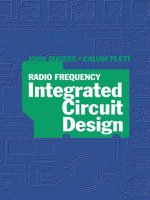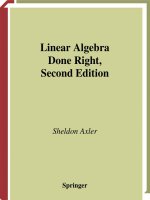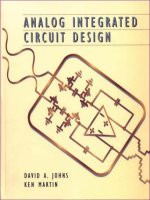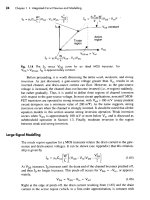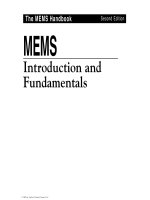Linear circuit design handbook 2nd edition
Bạn đang xem bản rút gọn của tài liệu. Xem và tải ngay bản đầy đủ của tài liệu tại đây (8.58 MB, 954 trang )
Linear Circuit Design Handbook
This page intentionally left blank
Linear Circuit Design Handbook
Hank Zumbahlen
with the engineering staff of Analog Devices
AMSTERDAM • BOSTON • HEIDELBERG • LONDON • NEW YORK • OXFORD
PARIS • SAN DIEGO • SAN FRANCISCO • SINGAPORE • SYDNEY • TOKYO
Newnes is an imprint of Elsevier
Cover images courtesy of Analog Devices
Newnes is an imprint of Elsevier
30 Corporate Drive, Suite 400, Burlington, MA 01803, USA
Linacre House, Jordan Hill, Oxford OX2 8DP, UK
Copyright © 2008 by Analog Devices. All rights reserved.
No part of this publication may be reproduced, stored in a retrieval system, or transmitted in any form or by
any means, electronic, mechanical, photocopying, recording, or otherwise, without the prior written
permission of the publisher.
Permissions may be sought directly from Elsevier ’ s Science & Technology Rights Department in Oxford,
UK: phone: ( ϩ 44) 1865 843830, fax: ( ϩ 44) 1865 853333, E-mail: You may also
complete your request online via the Elsevier homepage () , by selecting “ Support &
Contact ” then “ Copyright and Permission ” and then “ Obtaining Permissions. ”
Recognizing the importance of preserving what has been written, Elsevier prints its books on acid-free paper
whenever possible.
Library of Congress Cataloging-in-Publication Data
Linear circuit design handbook / edited by Hank Zumbahlen ; with the engineering staff of Analog Devices.
p. cm.
ISBN 978-0-7506-8703-4
1. Electronic circuits. 2. Analog electronic systems. 3. Operational amplifi ers. I. Zumbahlen, Hank.
II. Analog Devices, inc.
TK7867.L57 2008
627.39 Ј 5 dc22 2007053012
British Library Cataloguing-in-Publication Data
A catalogue record for this book is available from the British Library.
ISBN: 978-0-7506-8703-4
For information on all Newnes publications
visit our Web site at www.books.elsevier.com
Typeset by Charon Tec Ltd (A Macmillan Company), Chennai, India
www.charontec.com
08 09 10 11 10 9 8 7 6 5 4 3 2 1
Printed in the United States of America
v
Contents
Preface ix
Chapter 1: The Op Amp 1
Section 1-1: Op Amp Operation 3
Section 1-2: Op Amp Specifi cations 25
Section 1-3: How to Read a Data Sheet 69
Section 1-4: Choosing an Op Amp 81
Chapter 2: Other Linear Circuits 83
Section 2-1: Buffer Amplifi ers 85
Section 2-2: Gain Blocks 89
Section 2-3: Instrumentation Amplifi ers 91
Section 2-4: Differential Amplifi ers 107
Section 2-5: Isolation Amplifi ers 109
Section 2-6: Digital Isolation Techniques 113
Section 2-7: Active Feedback Amplifi ers 123
Section 2-8: Logarithmic Amplifi ers 125
Section 2-9: High Speed Clamping Amplifi ers 131
Section 2-10: Comparators 137
Section 2-11: Analog Multipliers 147
Section 2-12: RMS to DC Converters 153
Section 2-13: Programmable Gain Amplifi ers 157
Section 2-14: Audio Amplifi ers 165
Section 2-15: Auto-Zero Amplifi ers 185
Chapter 3: Sensors 193
Section 3-1: Positional Sensors 195
Section 3-2: Temperature Sensors 215
Section 3-3: Charge Coupled Devices 241
Chapter 4: RF/IF Circuits 245
Section 4-1: Mixers 248
Section 4-2: Modulators 255
vi
Contents
Section 4-3: Analog Multipliers 257
Section 4-4: Logarithmic Amplifi ers 265
Section 4-5: Tru-Power Detectors 271
Section 4-6: VGAs 275
Section 4-7: Direct Digital Synthesis 281
Section 4-8: PLLs 289
Chapter 5: Fundamentals of Sampled Data Systems 307
Section 5-1: Coding and Quantizing 309
Section 5-2: Sampling Theory 327
Chapter 6: Converters 337
Section 6-1: DAC Architectures 340
Section 6-2: ADC Architectures 371
Section 6-3: Sigma–Delta Converters 407
Section 6-4: Defi ning the Specifi cations 431
Section 6-5: DAC and ADC Static Transfer Functions and DC Errors 433
Section 6-6: Data Converter AC Errors 443
Section 6-7: Timing Specifi cations 483
Section 6-8: How to Read a Data Sheet 487
Section 6-9: Choosing a Data Converter 509
Chapter 7: Data Converter Support Circuits 513
Section 7-1: Voltage References 515
Section 7-2: Analog Switches and Multiplexers 531
Section 7-3: Sample-and-Hold Circuits 555
Section 7-4: Clock Generation and Distribution Circuits 565
Chapter 8: Analog Filters 581
Section 8-1: Introduction 583
Section 8-2: The Transfer Function 587
Section 8-3: Time Domain Response 597
Section 8-4: Standard Responses 599
Section 8-5: Frequency Transformations 623
Section 8-6: Filter Realizations 629
Section 8-7: Practical Problems in Filter Implementation 653
Section 8-8: Design Examples 663
Chapter 9: Power Management 681
Section 9-1: Linear Voltage Regulators 684
vii
Contents
Section 9-2: Switch Mode Regulators 701
Section 9-3: Switched Capacitor Voltage Converters 741
Chapter 10: Passive Components 753
Section 10-1: Capacitors 755
Section 10-2: Resistors and Potentiometers 767
Section 10-3: Inductors 775
Chapter 11: Overvoltage Effects on Analog Integrated Circuits 779
Section 11-1: Overvoltage Effects 781
Section 11-2: Electrostatic Discharge 789
Section 11-3: EMI/RFI Considerations 799
Chapter 12: Printed Circuit-Board Design Issues 821
Section 12-1: Partitioning 824
Section 12-2: Traces 827
Section 12-3: Grounding 863
Section 12-4: Decoupling 881
Section 12-5: Thermal Management 885
Index 897
This page intentionally left blank
ix
This work is based on the work of many other individuals who have been involved with applications and
Analog Devices since the company started in 1965. Much of the material that appears in this work is based
on work that has appeared in other forms. My major job function in this case was one of editor. The list of
people I would like to credit for doing the pioneering work include: Walt Kester, Walt Jung, Paul Brokaw,
James Bryant, Chuck Kitchen, and many other members of Analog Devices technical community.
In addition many others contributed to the production of this edition by helping out with the production of
this book by providing invaluable assistance by proofreading and providing commentary. I especially want
to thank Walt Kester, Bob Marwin, and Judith Douville, who also did the indexing.
Again, many thanks to those involved in this project.
Hank Zumbahlen
Senior Staff Applications Engineer
Preface
This page intentionally left blank
CHAPTER 1
The Op Amp
■ Section 1-1: Op Amp Operation
■ Section 1-2: Op Amp Specifi cations
■ Section 1-3: How to Read a Data Sheet
■ Section 1-4: Choosing an Op Amp
This page intentionally left blank
3
Chapter Introduction
In this chapter we will discuss the basic operation of the op amp, one of the most common linear design
building blocks.
In Section 1-1 the basic operation of the op amp will be discussed. We will concentrate on the op amp from
the black box point of view. There are a good many texts that describe the internal workings of an op amp,
so in this work a more macro view will be taken. There are a couple of times, however, that we will talk
about the insides of the op amp. It is unavoidable.
In Section 1-2 the basic specifi cations will be discussed. Some techniques to compensate for some of the op
amps limitations will also be given.
Section 1-3 will discuss how to read a data sheet. The various sections of the data sheet and how to interpret
what is written will be discussed.
Section 1-4 will discuss how to select an op amp for a given application.
Introduction
The op amp is one of the basic building blocks of linear design. In its classic form it consists of two
input terminals—one of which inverts the phase of the signal, the other preserves the phase—and an
output terminal. The standard symbol for the op amp is given in Figure 1-1 . This ignores the power supply
terminals, which are obviously required for operation.
Inputs
(ϩ)
(Ϫ)
ϩ
Ϫ
Figure 1-1 : Standard op amp symbol
SECTION 1-1
Op Amp Operation
4
Chapter One: The Op Amp
The name “ op amp ” is the standard abbreviation for operational amplifi er. This name comes from the early
days of amplifi er design, when the op amp was used in analog computers. (Yes, the fi rst computers were
analog in nature, rather than digital.) When the basic amplifi er was used with a few external components,
various mathematical “ operations ” could be performed. One of the primary uses of analog computers was
during World War II, when they were used for plotting ordinance trajectories.
Voltage Feedback Model
The classic model of the voltage feedback (VFB) op amp incorporates the following characteristics:
1. Infi nite input impedance
2. Infi nite bandwidth
3. Infi nite gain
4. Zero output impedance
5. Zero power consumption
None of these can be actually realized, of course. How close we come to these ideals determines the quality
of the op amp.
This is referred to as the VFB model. This type of op amp comprises nearly all op amps below 10 MHz
bandwidth and on the order of 90% of those with higher bandwidths ( Figure 1-2 ).
Positive supply
•
Ideal op amp attributes
–
Infinite differential gain
–
Zero common mode gain
–
Zero offset voltage
–
Zero bias current
–
Infinite bandwidth
•
Op amp input attributes
–
Infinite impedance
–
Zero bias current
–
Respond to differential voltages
–
Do not respond to common mode voltages
•
Op amp output attributes
–
Zero impedance
Negative supply
Output
Inputs
(ϩ)
(Ϫ)
ϩ
Ϫ
Op amp
Figure 1-2 : The attributes of an ideal op amp
Basic Operation
The basic operation of the op amp can be easily summarized. First we assume that there is a portion of the
output that is feedback to the inverting terminal to establish the fi xed gain for the amplifi er. This is negative
feedback. Any differential voltage across the input terminals of the op amp is multiplied by the amplifi er ’ s
open-loop gain. If the magnitude of this differential voltage is more positive on the inverting ( Ϫ ) terminal
than on the non-inverting ( ϩ ) terminal, the output will go more negative. If the magnitude of the
differential voltage is more positive on the non-inverting ( ϩ ) terminal than on the inverting ( Ϫ ) terminal,
the output voltage will become more positive. The open-loop gain of the amplifi er will attempt to force the
differential voltage to zero. As long as the inouts and output stays in the operational range of the amplifi er,
it will keep the differential voltage at zero and the output will be the input voltage multiplied by the gain
5
Section 1-1: Op Amp Operation
set by the feedback. Note from this that the inputs respond to differential-mode not common-mode input
voltage:
A ϭϪ
R
R
FB
IN
(1-1)
Inverting and Non-Inverting Confi gurations
There are two basic ways confi gure the VFB op amp as an amplifi er. These are shown in Figure 1-3 and
Figure 1-4 .
Figure 1-3 shows what is known as the inverting confi guration. With this circuit, the output is out of phase
with the input. The gain of this circuit is determined by the ratio of the resistors used and is given by:
A
R
R
FB
IN
ϭϪ
(1-2a)
Figure 1-4 shows what is know as the non-inverting confi guration. With this circuit, the output is in phase
with the input. The gain of the circuit is also determined by the ratio of the resistors used and is given by:
A
R
R
FB
IN
ϭϩ1
(1-2b)
Note that since the output drives a voltage divider (the gain setting network) the maximum voltage available
at the inverting terminal is the full output voltage, which yields a minimum gain of 1.
Also note that in both cases the feedback is from the output to the inverting terminal. This is negative feedback
and has many advantages for the designer. These will be discussed in more detail further in this chapter.
It should also be noted that the gain is based on the ratio of the resistors, not their actual values. This means
that the designer can choose just about any value he or she wishes within practical limits.
If the value of the resistors is too low, a great deal of current would be required from the op amps output
for operation. This causes excessive dissipation in the op amp itself, which has many disadvantages. The
increased dissipation leads to self-heating of the chip, which could cause a change in the DC characteristics
of the op amp itself. Also the heat generated by the dissipation could eventually cause the junction
temperature to rise above the 150 ° C, the commonly accepted maximum limit for most semiconductors.
V
IN
V
OUT
Op amp
R
FB
R
IN
Summing point
ϩ
Ϫ
R
FB
R
IN
G ϭ
V
IN
V
OUT
ϭ 1ϩ
Figure 1-3 : Inverting-mode op amp stage
6
Chapter One: The Op Amp
The junction temperature is the temperature at the silicon chip itself. On the other end of the spectrum, if
the resistor values are too high, there is an increase in noise and the susceptibility to parasitic capacitances,
which could also limit bandwidth and possibly cause instability and oscillation.
From a practical sense, resistors below 10 and above 1 M become increasingly diffi cult to purchase
especially if precision resistors are required.
Let us look at the case of an inverting amp in a little more detail. Referring to Figure 1-5 , the non-inverting
terminal is connected to ground. (We are assuming a bipolar ( ϩ and Ϫ ) power supply.) Since the op amp
will force the differential voltage across the inputs to zero, the inverting input will also appear to be at
ground. In fact, this node is often referred to as a “ virtual ground .”
V
IN
Op amp
R
FB
R
IN
I1
I2
V
OUT
ϩ
Ϫ
Figure 1-5 : Inverting amplifi er gain
If there is a voltage (V
IN
) applied to the input resistor, it will set up a current (I1) through the resistor (R
IN
)
so that:
I
V
R
IN
IN
1 ϭ
(1-3)
V
IN
V
OUT
Op amp
R
FB
R
IN
ϩ
Ϫ
R
FB
R
IN
G ϭ
V
IN
V
OUT
ϭ 1ϩ
Figure 1-4 : Non-inverting-mode op amp stage
7
Section 1-1: Op Amp Operation
Since the input impedance of the op amp is infi nite, no current will fl ow into the inverting input. Therefore,
this same current (I1) must fl ow through the feedback resistor (R
FB
). Since the amplifi er will force the
inverting terminal to ground, the output will assume a voltage (V
OUT
) such that:
VI1R
OUT FB
ϭϫ (1-4)
Doing a little simple arithmetic we then can come to the conclusion of Eq. (1-1):
V
V
A
R
R
OUT
IN
FB
IN
ϭϭϪ
(1-5)
Now we examine the non-inverting case in more detail. Referring to Figure 1-6 , the input voltage is applied
to the non-inverting terminal. The output voltage drives a voltage divider consisting of R
FB
and R
IN
. The
name “ R
IN
,” in this instance, is somewhat misleading since the resistor is not technically connected to the
input, but we keep the same designation since it matches the inverting confi guration, has become a de facto
standard, anyway. The voltage at the inverting terminal (V
a
), which is at the junction of the two resistors, is:
V
R
RR
V
a
IN
IN FB
OUT
ϭ
ϩ
(1-6)
The negative feedback action of the op amp will force the differential voltage to 0 so:
VV
aIN
ϭ
(1-7)
Again applying a little simple arithmetic we end up with:
V
V
RR
R
R
R
OUT
IN
FB IN
IN
FB
IN
ϭ
ϩ
ϭϩ1
(1-8)
Which is what we specifi ed in Eq. (1-2).
R
FB
R
IN
G ϭ
V
IN
V
OUT
ϭ 1ϩ
V
IN
V
OUT
I
R
FB
R
IN
ϩ
Ϫ
Figure 1-6 : Non-inverting amplifi er gain
In all of the discussions above, we referred to the gain setting components as resistors. In fact, they are
impedances, not just resistances. This allows us to build frequency dependent amplifi ers. This will be
covered in more detail in a later section.
8
Chapter One: The Op Amp
Open-Loop Gain
The open-loop gain (usually referred to as A
VOL
) is the gain of the amplifi er without the feedback loop
being closed, hence the name “ open loop .” For a precision op amp this gain can be vary high, on the order
of 160 dB or more. This is a gain of 100 million. This gain is fl at from DC to what is referred to as the
dominant pole. From there it falls off at 6 dB/octave or 20 dB/decade. (An octave is a doubling in frequency
and a decade is ϫ 10 in frequency.) This is referred to as a single pole response. It will continue to fall at
this rate until it hits another pole in the response. This second pole will double the rate at which the open-
loop gain falls, i.e., to 12 dB/octave or 40 dB/decade. If the open-loop gain has dropped below 0 dB (unity
gain) before it hits the second pole, the op amp will be unconditionally stable at any gain. This will be
typically referred to as unity gain stable on the data sheet. If the second pole is reached while the loop gain
is greater than 1 (0 dB), then the amplifi er may not be stable under some conditions ( Figure 1-7 ).
Open-
loop
gain
(dB)
Open-
loop
gain
(dB)
6 dB/Octave
6 dB/Octave
12 dB/
Octave
Single pole response Two pole response
Figure 1-7 : Open-loop gain (Bode plot)
It is important to understand the differences between open-loop gain, closed-loop gain, loop gain, signal gain,
and noise gain ( Figures 1-8 and 1-9 ). They are similar in nature, interrelated, but different. We will discuss
them all in detail.
Gain
(dB)
log ff
CL
Open-loop gain
Loop gain
Closed-loop gain
Noise gain
Figure 1-8 : Gain defi nition
The open-loop gain is not a precisely controlled specifi cation. It can, and does, have a relatively large range
and will be given in the specifi cations as a typical number rather than a min/max number, in most cases. In
some cases, typically high precision op amps, the specifi cation will be a minimum.
9
Section 1-1: Op Amp Operation
-
IN
+
A
B
IN
-
IN
+
ININ
+
ININ
+
R
1
|| R
3
IN
R
1
R
2
IN
R
1
R
2
Signal gain ϭ 1 ϩ R
2
/R
1
Noise gain ϭ 1 ϩ R
2
/R
1
Signal gain ϭ ϪR
2
/R
1
Noise gain ϭ 1 ϩ R
2
/R
1
Signal gain ϭ ϪR
2
/R
1
Noise gain ϭ 1 ϩ
•
Voltage noise and offset voltage of the op amp are reflected to the
output by the noise gain.
•
Noise gain, not signal gain, is relevant in assessing stability.
•
Circuit C has unchanged signal gain, but higher noise gain, thus
better stability, worse noise, and higher output offset voltage.
ϩ
Ϫ
ϩ
Ϫ
R
2
+
C
+++
IN
R
1
ϩ
Ϫ
R
2
R
3
Figure 1-9 : Noise gain
In addition, the open-loop gain can change due to output voltage levels and loading. There is also some
dependency on temperature. In general, these effects are of a very minor degree and can, in most cases, be
ignored. In fact this nonlinearity is not always included in the data sheet for the part.
Gain-Bandwidth Product
The open-loop gain falls at 6 dB/octave. This means that if we double the frequency, the gain falls to
half of what it was. Conversely, if the frequency is halved, the open-loop gain will double, as shown in
Figure 1-8 . This gives rise to what is known as the Gain-Bandwidth Product. If we multiply the open-loop
gain by the frequency, the product is always a constant. The caveat for this is that we have to be in the part
of the curve that is falling at 6 dB/octave. This gives us a convenient fi gure of merit with which to determine
if a particular op amp is useable in a particular application ( Figure 1-10 ).
For example, if we have an application with which we require a gain of 10 and a bandwidth of 100 kHz, we
require an op amp with, at least, a gain-bandwidth product of 1 MHz. This is a slight oversimplifi cation.
Because of the variability of the gain-bandwidth product, and the fact that at the location where the
closed-loop gain intersects the open-loop gain the response is actually down 3 dB, a little margin should be
included. In the application described above, an op amp with a gain-bandwidth product of 1 MHz would be
marginal. A safety factor of at least 5 would be better insurance that the expected performance is achieved.
Stability Criteria
Feedback theory states that the closed-loop gain must intersect the open-loop gain at a rate of 6 dB/octave
(single pole response) for the system to be stable. If the response is 12 dB/octave (two pole response) the
op amp will oscillate. The easiest way to think of this is that each pole adds 90 ° of phase shift. Two poles
then means 180 ° , and 180 ° of phase shift turns negative feedback into positive feedback, which means
oscillations.
10
Chapter One: The Op Amp
X
Y
f
CL
ϭ
log f
f
CL
Y ϭ 1 ϩ
R
2
R
1
Noise gain ϭ Y
Gain
(dB)
Open-loop gain, A(s)
if gain bandwidth product ϭ X
then Y ϫ f
CL
ϭ X
where f
CL
ϭ Closed-loop
bandwidth
Figure 1-10 : Gain-bandwidth product
The question could be then, why would you want an amplifi er that is not unity gain stable. The answer
is that for a given amplifi er, the bandwidth can be increased if the amplifi er is not unity gain stable.
This is sometimes referred to as decompensated, but the gain criteria must be met. This criteria is that the
closed-loop gain must intercept the open-loop gain at a slope of 6 dB/octave (single pole response). If not,
the amplifi er will oscillate.
As an example, compare the open-loop gain graphs in Figures 1-11, 1-12, 1-13 . The three parts shown,
the AD847, AD848, and AD849, are basically the same part. The AD847 is unity gain stable. The
AD848 is stable for gains of two or more. The AD849 is stable for a gain of 10 or more.
100
100
80
60
40
20
0
80
60
40
Open-loop gain (dB)
Phase margin (degrees)
20
100 1 k 10 k 1 M 10 M 100 M100 k
Frequency (Hz)
0
Ϫ20
Ϯ15 V Supplies
1k Load
Ϯ5 V Supplies
500 Load
Figure 1-11 : AD847 open-loop gain
11
Section 1-1: Op Amp Operation
Phase Margin
One measure of stability is phase margin. Just as the amplitude response does not stay fl at and then change
instantaneously, the phase will also change gradually, starting as much as a decade back from the corner
frequency. Phase margin is the amount of phase shift that is left until you hit 180 ° measured at the unity
gain point.
The manifestation of low phase margin is an increase in the peaking of the output just before the close loop
gain intersects the open-loop gain (see Figure 1-14 ).
100
100
80
60
40
20
0
80
60
40
Open-loop gain (dB)
Phase margin (degrees)
20
100 1 k 10k 1M 10M 100M100 k
Frequency (Hz)
0
Ϫ20
Ϯ15 V Supplies
1k Load
Ϯ 5 V Supplies
500 Load
Figure 1-12 : AD848 open-loop gain
120
100
80
60
40
20
0
100
80
60
Open-loop gain (dB)
Phase margin (degrees)
40
100 1 k 10k 1M 10 M 100 M100 k
Frequency (Hz)
20
0
Ϯ15 V Supplies
1k Load
Ϯ5 V Supplies
500 Load
Figure 1-13 : AD849 open-loop gain
12
Chapter One: The Op Amp
Closed-Loop Gain
This, of course, is the gain of the amplifi er with the feedback loop closed, as opposed the open-loop gain,
which is the gain with the feedback loop opened. It has two forms, signal gain and noise gain. These are
described and differentiated below.
The expression for the gain of a closed-loop amplifi er involves the open-loop gain. If G is the actual gain,
N
G
is the noise gain (see below), and A
VOL
is the open-loop gain of the amplifi er, then:
GN
N
NA
N
N
A
G
G
2
G VOL
G
G
VOL
ϭϪ
ϩ
ϭ
ϩ1
(1-9)
From this you can see that if the open-loop gain is very high, which it typically is, the closed-loop gain of
the circuit is simply the noise gain.
Signal Gain
This is the gain applied to the input signal, with the feedback loop connected. In the basic operation section
above, when we talked about the gain of the inverting and non-inverting circuits, we were actually more
correctly talking about the closed-loop signal gain. It can be inverting or non-inverting. It can even be less than
unity for the inverting case. Signal gain is the gain that we are primarily interested in when designing circuits.
The signal gain for an inverting amplifi er stage is:
A
R
R
FB
IN
ϭϪ
(1-10)
and for a non-inverting amplifi er it is:
A
R
R
FB
IN
ϭϩ1
(1-11)
80
70
60
50
40
Open loop gain (dB)
30
20
10
30 k 100k 1 M 10 M
Frequency (Hz)
100 M 500 M
180
135
90
Phase margin (degrees)
45
0
0
Ϫ10
Ϫ20
Gain
Phase
45 Phase
margin
V
S
ϭ ϩ5V
R
L
ϭ 2k
C
L
ϭ 5pF
Figure 1-14 : AD8051 phase margin
13
Section 1-1: Op Amp Operation
Noise Gain
Noise gain is the gain applied to a noise source in series with an op amp input. It is also the gain applied to
an offset voltage. The noise gain is equal to:
A
R
R
FB
IN
ϭϩ1
(1-12)
Noise gain is equal to the signal gain of a non-inverting amp. It is the same for either an inverting or non-
inverting stage.
It is the noise gain that is used to determine stability. It is also the closed-loop gain that is used in Bode
plots. Remember that even though we used resistances in the equation for noise gain, they are actually
impedances (see Figure 1-9 ).
Loop Gain
The difference between the open- and the closed-loop gain is known as the loop gain. This is useful
information because it gives you the amount of negative feedback that can apply to the amplifi er system
(see Figure 1-8 ).
Bode Plot
The plotting of open-loop gain versus frequency on a log–log scale gives is what is known as a Bode
(pronounced boh dee ) plot. It is one of the primary tools in evaluating whether a particular op amp is
suitable for a particular application.
If you plot the open-loop gain and then the noise gain on a Bode plot, the point where they intersect will
determine the maximum closed-loop bandwidth of the amplifi er system. This is commonly referred to as
the closed-loop frequency (F
CL
). Remember that the true response at the intersection is actually 3 dB down.
One octave above and one octave below F
CL
, the difference between the asymptotic response and the real
response will be less than 1 dB ( Figure 1-15 ).
Open-loop gain
Noise gain
f
CL
40
30
20
10
10 MHz3.0 MHz1.0 MHz300 KHz100 KHz30 KHz10KHz
0
Frequency
Gain
Figure 1-15 : Asymptotic response
14
Chapter One: The Op Amp
The Bode plot is also useful in determining stability. As stated above, if the closed-loop gain (noise gain)
intersects the open-loop gain at a slope of greater than 6 dB/octave (20 dB/decade), the amplifi er may be
unstable (depending on the phase margin).
Current Feedback Model
There is a type of amplifi ers that have several advantages over the standard VFB amplifi er at high fre-
quencies. They are called current feedback (CFB) or sometimes transimpedance amps. There is a
possible point of confusion since the current-to-voltage (I/V) converters commonly found in photo -
diode applications are also referred to as transimpedance amps. Schematically CFB op amps look
similar to standard VFB amps, but there are several key differences.
The input structure of the CFB is different from the VFB. While we are trying not to get into the internal
structures of the op amps, in this case a simple diagram is in order (see Figure 1-16 ). The mechanism of
feedback is also different, hence the names. But again, the exact mechanism is beyond what we want to
cover here. In most cases if the differences are noted, and the attendant limitations observed, the basic
operation of both types of amplifi ers can be thought of as the same. The gain equations are the same as for
a VFB amp, with an important limitation as noted in the next section.
Ϫ
v
ϪA(s) v
A(s) ϭ Open-loop gain
V
OUT
ϭ A(s)*v
V
IN
Ϫ
i
Ϫ
T(s) i
T(s)
R
O
i
ϫ1
R
2
R
1
V
IN
V
OUT
ϫ1
V
OUT
ϩ
R
2
R
1
ϩ
i
T(s) ϭ Transimpedance open-loop gain
V
OUT
ϭ ϪT(s)*i
~
Figure 1-16 : VFB and CFB amplifi ers
Difference from VFB
One primary difference between the CFB and VFB amps is that there is not a gain-bandwidth product.
While there is a change in bandwidth with gain, it is not even close to the 6 dB/octave that we see with
VFB (see Figure 1-17 ). Also, a major limitation is that the value of the feedback resistor determines
the bandwidth, working with the internal capacitance of the op amp. For every CFB op amp there is a
recommended value of feedback resistor for maximum bandwidth. If you increase the value of the resistor,
reduce the bandwidth. If you use a lower value of resistor, the phase margin is reduced and the amplifi er
could become unstable. This optimum value of resistor is different for different operational conditions. For
instance, the value will change for different packages, e.g., SOIC versus DIP (see Figure 1-18 ).
Also, a CFB amplifi er should not have a capacitor in the feedback loop. If a capacitor is used in the
feedback loop, it reduces the feedback impedance as frequency is increased, which will cause the op amp to



